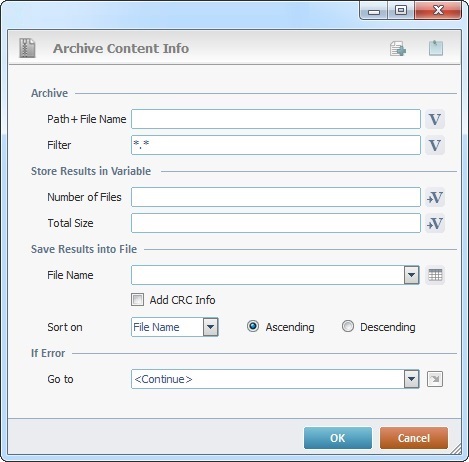Working with Archive Content Info Process
Process Purpose
The "Archive Content Info" process is used to get info from an archive file (= compressed file).
![]()
Note that the archive files "*.zip" and "*.zipx" are valid and that multipart archive files are NOT supported.
When you add a process, you are required to define its settings. This occurs in the process's properties window which is displayed automatically after having added the "Archive Content Info" process.
If any subsequent edition is required, double-click the process to open its properties window and enter the necessary modifications.

Proceed as follows:
Archive |
|
Path + File Name |
Enter the file's name and path OR click |
Filter |
Enter the filter to use in the content check OR click |
Store Results in Variable |
|
Number of Files |
Click |
Total Size |
Click |
Save Results into File |
|
File Name |
Select the file to be used to store the archive content info from the drop-down. If required, click |
Add CRC Info |
Check this option to add the CRC of each archived file in the results file. |
Sort on |
Select the information to base the sorting on ("File Name"; "Extension"; "Date" or "Size") from the drop-down. |
Ascending |
If needed, check this option to define an ascending order for the sorting. |
Descending |
If needed, check this option to define a descending order for the sorting. |
If Error |
|
Go to |
Select a target location from the drop-down or the
|
Detail of ![]() window:
window:

"S:Menu" is a screen included in the same program as the process.
"R:Routine_1" is a routine included in the same program as the process.
If required, use the icons on the upper right corner of the process properties window:
![]() Click this icon to create a new data file. Go to Creating a Data File to see how to fill in the several options available.
Click this icon to create a new data file. Go to Creating a Data File to see how to fill in the several options available.
![]() Use the icon to attach any relevant notes to this process. Click it and enter your notes in the resulting text box. These notes will be displayed in the corresponding "Actions" tab or "Process" window (in the "Notes" field) and in the "Developer Report".
Use the icon to attach any relevant notes to this process. Click it and enter your notes in the resulting text box. These notes will be displayed in the corresponding "Actions" tab or "Process" window (in the "Notes" field) and in the "Developer Report".
After filling in the required options, click ![]() to conclude or
to conclude or ![]() to abort the operation.
to abort the operation.
The added process is displayed in the corresponding "Actions" tab or "Process" window.
![]() You can use relative paths to refer the file(s) you want to use in your project. See Working with Aliases.
You can use relative paths to refer the file(s) you want to use in your project. See Working with Aliases.
![]() If you want to use a label as a target destination, you can use the "Auto-Label" mechanism. This alternative to the "Set Label" process allows you to create a label in the properties window of a process - specifically, in the fields used to define target destinations (ex: the "If Error..." type fields). See To Automatically Create a Label.
If you want to use a label as a target destination, you can use the "Auto-Label" mechanism. This alternative to the "Set Label" process allows you to create a label in the properties window of a process - specifically, in the fields used to define target destinations (ex: the "If Error..." type fields). See To Automatically Create a Label.
![]()
Use the right-click in MCL-Designer's input boxes to access some related options as well as the general "Cut", "Copy"; "Paste"; "Search" actions (active/inactive according to the current context).
Ex: If you right-click the "Variable" input box (included in a "Conversion's" properties window), you are provided with general editing/search actions and other more specific options such as "Variable Select" (see "Variable Select"); "Variable Insert" (see "Variable Insert"); "Insert Special Character" (see To Insert Special Characters into a Control's Text Input Field) and "Localization Select" (see Localization List).
If you right-click another input box, it may provide other possibilities.
